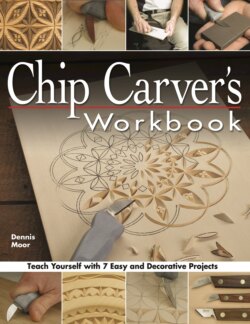Читать книгу Chip Carver's Workbook - Dennis Moor - Страница 8
ОглавлениеINTRODUCTION
CHIP CARVING IN TYPICAL CHIPPING AWAY STYLE
EASIER THAN YOU MIGHT THINK
by Todd Moor
As life gets more complex and stressful, I find myself more appreciative of the simple escapes it offers. One such blessing I have is a hobby that has turned into a full-time profession. Chip carving has a long history of use in decorating various wooden household items, including furniture, as well as in creating purely artistic pieces. Although the finished chip-carved pieces often display an intricacy and beauty one may think is attainable only by a long-lived master carver, chip carving can be surprisingly easy to learn. My father deserves much of the credit for this. He taught me a simple and effective method for chip carving a limitless variety of designs. Working together, we have taught this chip carving method to well over 2,000 students worldwide. Our chip carving students have included both men and women, from adolescents to octogenarians and all ages in between. I have seen some hold skepticism as to whether or not they could chip carve, and keep in mind that I have never met a person who cannot.
DEFINITION OF CHIP CARVING
Chip carving is a style of woodcarving in which knives are used to remove selected “chips” of wood from the project in a single piece. In theory, chip carvings have just two levels, or planes: the wood surface and the point beneath the surface where the cuts meet. Patterns can be free-form style or geometrically based with figures, such as triangles, circles, simple lines, and curves. If we accept this definition of chip carving, we find that almost every society throughout history has experimented with it, which makes the precise origins of chip carving debatable. It has been my experience that the strongest factor in such arguments is usually the nationality of the debater. I believe that this simple definition of chip carving allows us to consider that it originated in various societies without the necessity of influence from other groups. I find comfort in the notion that chip carving has a rich and long history for all of us, deep in our common cultural identities.
There are variations in the tools and designs favored by chip carvers of various cultural backgrounds. My father and I have a simple approach to understanding chip carving that offers the advantages of minimizing both the number of tools and rules the student needs to learn. In fact, I’ve found the reasons underlying such “rules” are worthy of greater emphasis than the rules themselves. There are times when the rules must be broken, and a good understanding of chip carving will help you know when to break them.
POP’S TEN COMMANDMENTS FOR CHIP CARVERS
Say, I don’t believe I have told you why so many call me “Pop.” During the early days of Chipping Away, my son, Todd, and I exhibited at wood shows and taught classes together. Todd has always called me “Pop,” and whenever he would holler “Hey, Pop!” across a room, it didn’t take long for others to join in. While I was teaching a class at the Thunder Mountain Wood Carvers Club in Sierra Vista, Arizona, Don Yadusky, a student in the class, kept lots of notes. At the close of the class, he announced that by using his observations, he created “Pop’s Ten Commandments for Chip Carvers.” I would like to share them with you.
1 Remove the largest chips first.
2 Carve those areas that are the most delicate (sharp ridges) last.
3 When carving rosettes, start with cuts that are diagonal to the grain and move in one direction only. Using this progression, you will remove the more difficult cross-grained chips before finishing with the easier, with-the-grain ones.
4 When carving into the center of a rosette, roll your knife up to almost 90 degrees. This technique will keep the center from chipping out, especially in those patterns where you will be carving into the center a number of times.
5 If you have trouble removing large chips with one cut, then carve in stages. You will find that by taking smaller chips out of the center of the large one and gradually increasing the size, the final chip will be much easier to remove. Your carving will also be much neater and cleaner.
6 When starting a new chip, always make the first cut with the blade facing away from your previous chip.
7 Make use of stop cuts.
8 Keep your thumb against the handle blade and on the wood at all times. This thumb position will ensure consistent angles and will minimize the chance of cutting yourself.
9 Always look for ways to add that final touch or embellishment—create the “ooohhs.”
10 Have fun!
